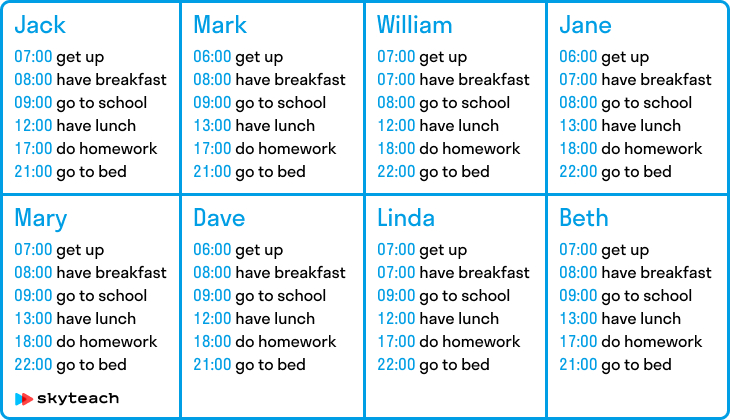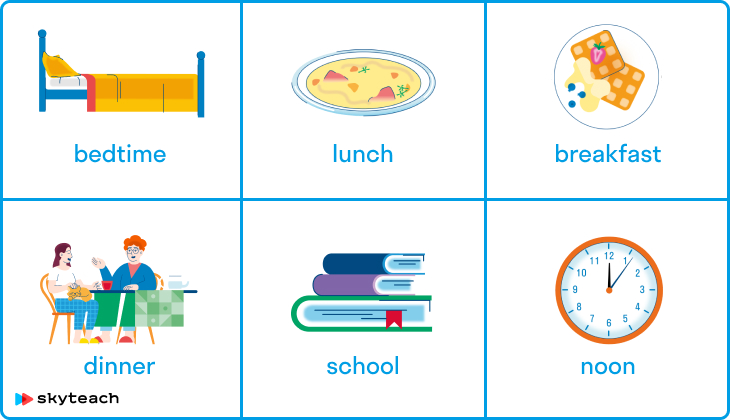Activity
Let’s face it, studying vocabulary is not something most children are exactly thrilled to do. Make it fun with this competitive family game! Pick a word of the day and see who can use it correctly the most times. This game will help your child learn new words by getting her to use them in real conversations. Increasing your child’s vocabulary is important for her grasp of the English language, and can also help her score higher on those tricky standardized tests.
What You Need:
- 20 index cards
- Black marker
- Pencil
- Ruler
- Bag or box
- Poster board
- Invisible tape
- Dictionary
What You Do:
- Prepare for the game: With the black marker, write a different vocabulary word on each index card and then put them all into a box or bag. For pointers on what words to use, you may want to look over your child’s homework or check with a teacher to see which vocabulary words your child needs to learn.
- At the top of the poster board, have your child write a title, such as «Word of the Day,» in big block letters. Leave some space underneath for the rest of the project.
- Use the pencil to trace an index card 5 times on the poster board, arranging the 5 rectangles like 5 dots on a domino. Leave some room around each rectangle so you have space to write the days of the week, and be sure to leave several inches at the bottom of the poster where you will write the names of each family member.
- Above each rectangle, have your child write the days of the week in order. Monday should be the top-left rectangle, Wednesday should be the one in the center, and Friday should be on the bottom-right.
- Underneath that, use the ruler to divide the remaining space into four equal quadrants. Invite your child to write each family member’s name in the upper-left corner of each quadrant and be sure she leaves enough space for tally marks to keep score. (Note: for families with more than 4 members, have one or both parents sit out so the kids can compete against each other.)
- How to play: At breakfast each day, have your child draw a word from the bag and read it out loud. If anyone can define the word, encourage them to explain it to the rest of the family. If not, look it up in the dictionary and then give examples of the ways you could use the word in a conversation.
- Give your child a piece of Scotch removable tape and then have her paste it under the correct day of the week.
- The object of the game is to see which family member can use the word the most times correctly in conversation. Have each person keep track of how many times they use it in that day. Maybe add to the challenge by seeing who can come up with the most creative or silly way to use the word in a sentence!
- At dinner time, each family member will share how many times they use the word during the day and for each time someone used it, have your child put a tally mark next to their name. Share stories with each other about how you used the word, and with whom.
- For the rest of the week, your child will draw a new card every morning and tape it to the poster, and every evening your child will tally up each family member’s score.
- On the weekend, the goal is to use as many of the 5 words that were used during the week in conversation. But if you’d rather take a break on the weekend, that’s fine too, just skip to the next step.
- On Sunday, help your child add up all the points that each family member received over the week. Whoever has the most points gets the title «Word of the Day Champion!» Reward the vocabulary whiz by letting her choose what’s for dinner that night or what movie the family will watch. Another idea: make a silly «crown» out of an old hat or construction paper that the Word of the Day champion can wear the rest of the week. This activity is a great way to increase your child’s vocabulary and get the whole family involved, but don’t expect to do it every week—you’ll run out of words!
Learning new vocabulary should be a daily activity. Having a ‘Word of the Day’ to focus on is a good way to encourage the learning of new words.
For this activity:
- Introduce a new word each day.
- Seasonal vocabulary can be a good starting place when deciding which words to focus on.
- Post the word on a whiteboard or piece of paper each morning.
- Discuss the meaning of the word, muddle up the letter cards and practice spelling the word.
- Make up a sentence including the word of the day.
- Write each word of the sentence on a different card and hide these cards around the room. Put the sentence in order and read it together.
Help your students learn important seasonal concepts through daily themed vocabulary/books/songs/no prep sheets
Sign Up for our newsletter and get a free PDF of…
·
Similar ideas popular now
Are you struggling with students paying attention? These morning activities will keep them engaged while they learn and build a strong classroom culture.
Dynamic Learning Teaching Experts for K-2 students!
These activities for St. Patrick’s Day provide fun and engaging active learning for kindergarten and first grade students. Read about how we used concept-based instruction while the kids have fun with St. Patrick’s Day activities. Read more!
Dynamic Learning Teaching Experts for K-2 students!
I was so excited to see what this kindergarten teacher did with our calendar words! She said they write about these calendar words every day and it has really improved their writing. I want y’all to try these words so grab this calendar for free for the next 24 hours! #calendars #vocabulary #kindergarten #soltrainlearning#firstgrade #secondgrade #teaching
Dynamic Learning Teaching Experts for K-2 students!
My kindergarten and first grade students learn and build great vocabulary as well as improve writing skills with my thematic approach to teaching. Read more on these thematic teaching ideas!
Dynamic Learning Teaching Experts for K-2 students!
These January emergent readers include real photos of the vocabulary and makes it beneficial to match the picture with the word. There are also comprehension questions and a teacher’s guide. #vocabulary#emergentreaders#firstgrade#literacy#phonics#soltrainlearning
Dynamic Learning Teaching Experts for K-2 students!
Transform Your Science of Reading Approach with Concept-Based Instruction — Dynamic Learning
As K-1 teachers, we all know how important engaging with students is. But sometimes, it’s so challenging! This simple shift in my instruction was so easy I could cry😂
Dynamic Learning Teaching Experts for K-2 students!
Are you looking for fun and engaging vocabulary activities for your kindergarten and 1st grade students for back to school? These monthly editable calendars provide great thematic vocabulary during your activities for morning meeting. Students will clap syllables, look for word features while they build vocabulary and increase writing skills. Read more about this discounted bundle!
Dynamic Learning Teaching Experts for K-2 students!
Dynamic Learning Teaching Experts for K-2 students!
This daily routine of greetings for morning meeting will make or break your classroom culture for the rest of the year. Read about more morning activities to strengthen your classroom culture!
Dynamic Learning Teaching Experts for K-2 students!
These games for science are great for active learning! Your kindergarten and first grade students will benefit greatly from concept based instruction. Read more!
Dynamic Learning Teaching Experts for K-2 students!
Looking for a fun game that teaches great fall vocabulary? Then check out these engaging Boom Cards by SOL Train Learning! They are self-checking and paperless and so fun for the students. There are activities that include definitions, syllables, phonics and finding words in sentences. These cards are great for Distance Learning! #distancelearning#boomcards#fall
Dynamic Learning Teaching Experts for K-2 students!
Discover a great way to introduce your young students to content vocabulary in this stress-free literacy plan. With 15 minutes a day, you will begin to see an increase in reading comprehension, writing skills, phonics and vocabulary. See what other teachers are saying!
Dynamic Learning Teaching Experts for K-2 students!
This vocabulary calendar teaches great daily words for each month and increases students’ phonics and writing skills. Great for ESL students! Read what other teachers are saying! #vocabulary#phonics#literacy#ESL
Dynamic Learning Teaching Experts for K-2 students!
Read about some simple ways to teach about maps to your primary students or younger children. They will create and sing and learn great vocabulary as they read about maps. Parents can use these resources at home for distance learning as well. #maps#socialstudies#distancelearning
Dynamic Learning Teaching Experts for K-2 students!
Dynamic Learning Teaching Experts for K-2 students!
Dynamic Learning Teaching Experts for K-2 students!
Dynamic Learning Teaching Experts for K-2 students!
There are over 200 pages in this fun and engaging February Literacy Bundle! You get books with real photos, centers, games, cut and paste vocabulary activities and more at a discounted price. #literacyactivities#soltrainlearning#vocabularyforelementary
Dynamic Learning Teaching Experts for K-2 students!
Do you struggle teaching your students content area vocabulary? Read how you can increase their vocabulary with this daily routine.
Dynamic Learning Teaching Experts for K-2 students!
These daily content area vocabulary words and emergent readers have helped this teacher’s students with reading, writing, and phonics as they learn great thematic vocabulary. Read more and check out her video testimony. #vocabularyactivities#vocabularyforelementary#emergentreaders#soltrainlearning#phonics
Dynamic Learning Teaching Experts for K-2 students!
These January emergent readers have real photos for students to make connections to vocabulary from our January calendar. There is a teacher guide included. #emergentreader#firstgrade#vocabulary#esl#january#soltrainlearning
Dynamic Learning Teaching Experts for K-2 students!
Read about how we use these January emergent readers and other literacy centers to teach vocabulary, sight words and phonics. #vocabularyactivities#sightwords#firstgrade#literacycenters#soltrainlearning#phonics
Dynamic Learning Teaching Experts for K-2 students!
Students love playing this word game. They learn great January vocabulary. There is a teacher guide included. #vocabulary#january#wordgame#soltrainlearning
Dynamic Learning Teaching Experts for K-2 students!
Тема My day во многих английских учебниках звучит как Daily routine. Название говорит само за себя: что-то скучное и неинтересное. Как подать тему о «рутине» увлекательно и ярко? Хотим предложить вам десять интересных заданий для введения и отработки этого материала в интерактивном формате, который поможет завладеть вниманием учеников.
Первое, что нужно сделать — помочь ученикам выучить новые выражения по теме “My Day”. Лексика запоминается быстрее, если предложить ученикам словарные игры.
1. Игры на Wordwall
Эти игры помогут выучить буквенные образы новых слов и выражений.
- Ссылка на игру Daily routine
- Ссылка на игру Daily life
2. Игры на базе Memory
Такие игры направлены на тренировку правильного произношения новых слов и выражений. Например, в игру “Memory” можно играть на ресурсе Learning Apps. Слова на карточках озвучиваются: поиграв в такую игру, ученик скоро запомнит, как правильно называть новые слова и фразы.
- Ссылка на игру
3. День любимого персонажа
В этой игре предстоит описать обычный день интересного героя (например, Рапунцель).
4. Спиннер или кубик
В этой игре мы предлагаем ученикам вспомнить десять слов и выражений по теме (важно, чтобы ребята сами составили этот список) и записываем их на доске.
Далее ученики работают в командах или индивидуально: по очереди бросают кубик или раскручивают спиннер.
- Ссылка на игру
С выражением, на которое указал кубик или спиннер, нужно составить предложение о себе или своей семье.
Предлагаем также идеи из статей:
5. Guess who I am!
Ученики работают в парах. Один загадывает карточку и рассказывает своему партнеру о дне своего героя. Второй участник должен угадать имя героя.

Имена на карточках можно заменить на интересных ученикам героев.
6. Небылица
В эту игру интереснее играть в группе от трех человек. Если это офлайн-урок, то ответы удобнее записывать на листе бумаги.
Участники отвечают на вопросы из списка. После того, как участник ответит, он сгибает край листа так, чтобы следующий ученик не видел его ответ.

7. Особенный день
Ученик должен выбрать карточку и рассказать про свой обычный распорядок в тот праздничный день, который на ней указан. Это могут быть любые популярные праздники:
- New Year Day (the 1st of January)
- New Year Eve (The 31st of December)
- Birthday
- Sunday
- Summer holidays
- Winter holidays, etc.
8. True/False
Преподаватель читает предложения, а ученик должен сказать, соответствует ли это утверждение его распорядку дня (True/False). Задача ученика — ответить на наибольшее количество предложений за 1 минуту. Это может быть соревнование нескольких учеников или индивидуальное задание.
9. Табу (секретное слово)
Перед началом игры мы выбираем слово, например, elephant. Далее ученик самостоятельно или по заданию педагога (или заданию в карточке) узнает слово, которое будет табу. Задача второго ученика — с помощью вопросов догадаться, что скрывается за секретным словом.
Игра будет интереснее, если дать ученикам ограниченное количество времени (1 или 2 минуты).
10. Before and after
Сначала ученик выбирает для себя одно из слов “before” или “after” и называет его. После этого он должен выбрать карточку и составить предложение. Примеры карточек:

Такие простые задания позволят ученикам быстро и увлекательно овладеть новой темой. Интересных вам уроков!
A word of the day activity with a variety of tasks to give context and meaning to a word.
A word of the day sheet to use with upper elementary students to practice dictionary and vocabulary skills.
The activity sheet includes:
- dictionary definition
- guide words on dictionary page
- syllabification
- pronunciation
- word origin
- part(s) of speech
- word forms
- use the word in a sentence
- definition in your own words
- list 5 synonyms for the word
- list 5 antonyms for the word.
This resource can be used in a variety of ways, such as:
- use as a whole-class warm-up activity.
- use in your reading small groups to practice dictionary skills.
- use as a reading center activity with unknown words from a piece of text.
Use the drop-down menu to choose between the PDF or interactive Google slide version.
You might like to use this activity in conjunction with our Parts of a Dictionary – Poster.
Curriculum
-
CCSS.ELA-LITERACY.L.4.4.C
Consult reference materials (e.g., dictionaries, glossaries, thesauruses), both print and digital, to find the pronunciation and determine or clarify the precise meaning of key words and phrases.
-
CCSS.ELA-LITERACY.L.5.4.C
Consult reference materials (e.g., dictionaries, glossaries, thesauruses), both print and digital, to find the pronunciation and determine or clarify the precise meaning of key words and phrases.
-
CCSS.ELA-LITERACY.L.6.4.C
Consult reference materials (e.g., dictionaries, glossaries, thesauruses), both print and digital, to find the pronunciation of a word or determine or clarify its precise meaning or its part of speech.
Teach Starter Publishing
We create premium quality, downloadable teaching resources for primary/elementary school teachers that make classrooms buzz!
Find more resources like this
- English Language Arts and Reading
- Reading
- Foundational Language Skills
- Vocabulary
- Guided Reading Activities
- Reading Center Activities
- Word of the Day / Week
- Dictionary Skills
- Online Teaching
- Worksheets
- Templates
- 4th Grade
- 5th Grade
- 6th Grade
- Google Slide





























